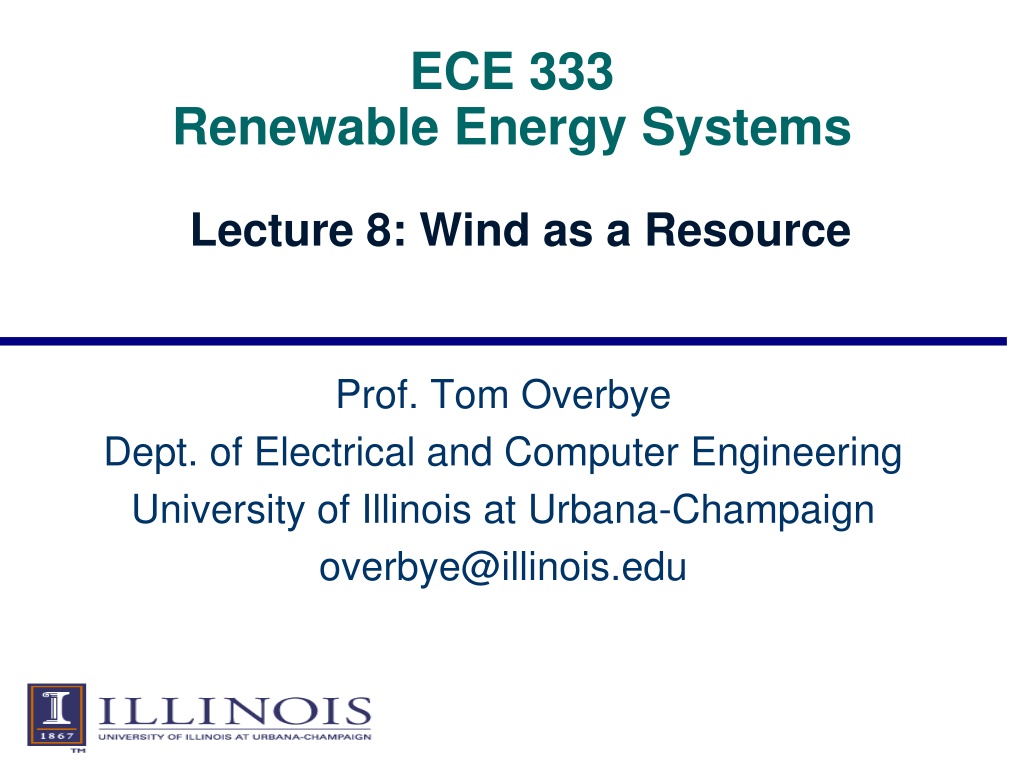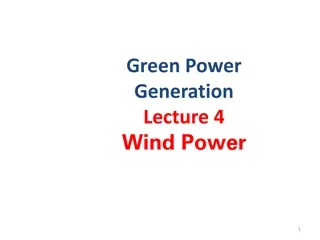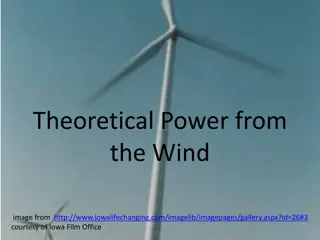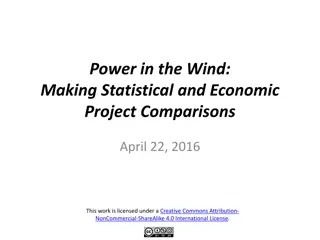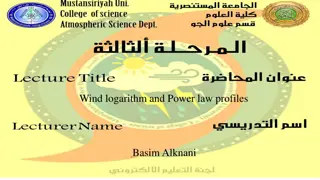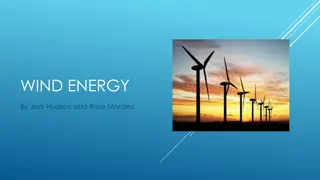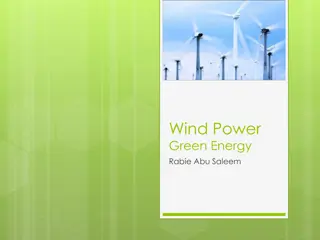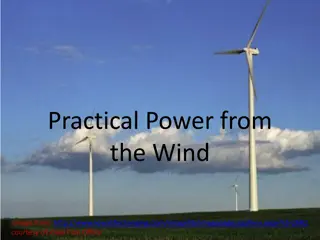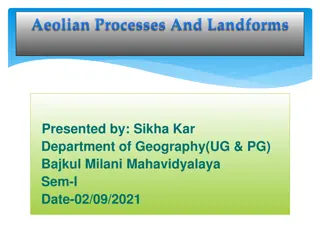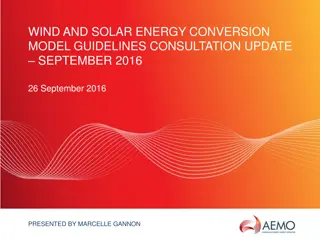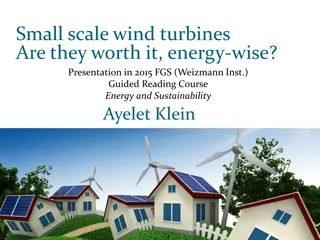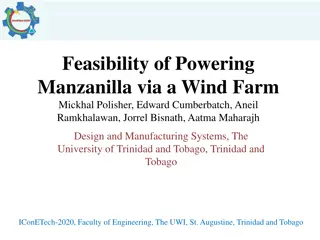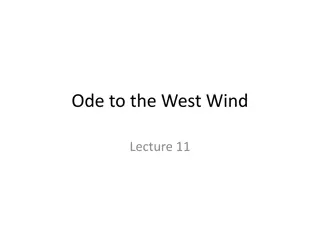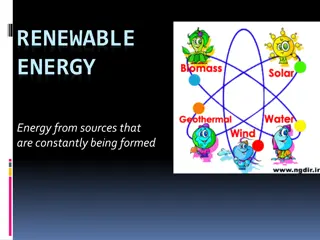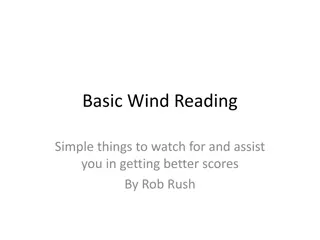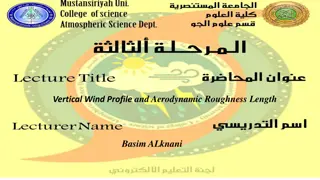Understanding Wind Power Generation: Key Concepts and Calculations
Exploring wind power generation concepts, this content delves into the physics behind harnessing wind energy, calculating power in the wind, understanding the impact of wind speed on power generation, and correlating wind turbine size with efficiency and cost-effectiveness. Key equations and examples are provided to illustrate the principles of wind power utilization and the relationship between wind speed, turbine size, and energy output.
Download Presentation

Please find below an Image/Link to download the presentation.
The content on the website is provided AS IS for your information and personal use only. It may not be sold, licensed, or shared on other websites without obtaining consent from the author. Download presentation by click this link. If you encounter any issues during the download, it is possible that the publisher has removed the file from their server.
E N D
Presentation Transcript
ECE 333 Renewable Energy Systems Lecture 8: Wind as a Resource Prof. Tom Overbye Dept. of Electrical and Computer Engineering University of Illinois at Urbana-Champaign overbye@illinois.edu
Announcements Read Chapter 7 Quiz on HW 3 Today HW 4 is 7.1, 7.2, 7.4, 7.5; it will be covered by an in- class quiz on Thursday Feb 20 1
Wind Turbine Sizes A 747 wing span is about 60m; The Washing- ton mon- ument is 169m high 2 http://www.bpwtag.ca/Bruce%20Peninsula%20Wind%20Turbine%20Sizes%202013.jpg
Power in the Wind Consider the kinetic energy of a packet of air with mass m moving at velocity v 1 KE 2mv = 2 Divide by time and get power 1 2 passing though A t m = 2 Power through area A v The mass flow rate is ( is air density) passing though A = m m = A v t 3
Power in the Wind Combining previous equations, 1 2 ( ) = 2 Power through area A A v v 1 2 = A (6.4) v 3 Power in the wind P W PW (Watts) = power in the wind (kg/m3)= air density (1.225kg/m3at 15 C and 1 atm) A (m2)= the cross-sectional area that wind passes through v (m/s)= windspeed normal to A (1 m/s = 2.237 mph) 4
Power in the Wind (for reference solar is about 600 w/m^2 in summer) Power increases with the cube of wind speed Doubling the wind speed increases the power by eight Energy in 1 hour of 20 mph winds is the same as energy in 8 hours of 10 mph winds Nonlinear, so we cannot use average wind speed 5
Power in the Wind 1 2 = A v 3 P W Power in the wind is also proportional to A For a conventional HAWT, A = ( /4)D2, so wind power is proportional to the blade diameter squared Cost is somewhat proportional to blade diameter This explains why larger wind turbines are more cost effective (plus, as we shall see, because they are higher, the winds are stronger) 6
Example: Energy in 1 m2 of Wind 1 2 = 3 Energy A v t 100 hours of 6 m/s winds ( Energy 1.225 kg/m (1m ) 6 m/s 100 h=13,230 Wh 2 1 ) ( ) 3 = 3 2 50 hours of 3 m/s winds and 50 hours of 9 m/s winds - *the average wind speed is 6 m/s ( Energy (3 m/s) 1.225 kg/m (1m ) 3 m/s 50 h=827 Wh 2 ( Energy (9 m/s) 1.225 kg/m (1m ) 9 m/s 50 h=22,326 Wh 2 Don t use average wind speed! 1 ) ) ( ) 3 = 3 2 1 ( ) 3 = 3 2 total = 23,152 Wh 7
Air Density for Different Temperatures and Pressures 3 M.W. 10 RT P = P = absolute pressure (atm) M.W. = molecular weight of air (g/mol) = 28.97 g/mol T = absolute temperature (K) R = ideal gas constant = 8.2056 10-5 m3 atm K-1 mol-1 Air density is greater at lower temperatures For example, in comparing 90 F (305 K) to 10 F 265.3 K), ratio is about 1.15 8
Air Density Altitude Correction dP dz = g = + = g dz ( ) ( ) dP P z dz P z We get a differential equation in terms of pressure: dP dz= 4 4 1.18510 e = 1.185 10 P H 1 atm P where H is in meters 9
Air Density Temperature and Altitude Impacts Variation in density with respect to temperature and altitude is given by 353.1exp( 0.0342 / ) kg/m T z T = 3 where T is in kelvins (K) and z is in meters above sea level With z=0, T=273.16+15 then = 1.225kg/m3 With z=200, T= 273.16+35, then = 1.225kg/m3 1.120 (about 91% of sea level, 15 degree C value) 10
Impact of Elevation and Earths Roughness on Windspeed Since power increases with the cube of wind speed, we can expect a significant economic impact from even a moderate increase in wind speed There is a lot of friction in the first few hundred meters above ground smooth surfaces (like water) are better Wind speeds are greater at higher elevations tall towers are better Forests and buildings slow the wind down a lot 11
Characterization of Elevation and Earth s Roughness on Wind Speed v v H H = 0 0 = friction coefficient given in Table 6.3 v = wind speed at height H v0 = wind speed at height H0 (H0 is usually 10 m) Typical value of in open terrain is 1/7 For a large city, = 0.4; for small town, = 0.3, for high crops, , = 0.2, for calm water or hard ground, = 0.1 12
Impact of Elevation and Earths Roughness on Wind speed Alternative formulation (used in Europe) ln( ln( / ) / ) l v v H l H = 0 0 lis the roughness length given in Table 7.2 Note that both equations are just approximations of the variation in wind speed due to elevation and roughness the best thing is to have actual measurements 13
Impact of Elevation and Earths Roughness on Power in the Wind Combining earlier equations we get 3 3 P P v v H H = = 0 0 0 The other constants in the power in the wind equation are the same, so they just cancel: 1 2 1 2 3 Av P P = 3 Av 0 0 14
Impact of Elevation and Earths Roughness on Windspeed Figure 7.16 For a small town, windspeed at 100 m is twice that at 10 m Areas with smoother surfaces have less variation with height 15
Example Rotor Stress Wind turbine with hub at 50-m and a 30-m diameter rotor, = 0.2 65 m Find the ratio of power in the wind at highest point to lowest point 50 m 3 0.2 35 m 65 35 P P = = 1.45 0 Power in the wind at the top of the blades is 45% higher! Picture may not be to scale 16
Maximum Rotor Efficiency Two extreme cases, and neither makes sense- Downwind velocity is zero turbine extracted all of the power Downwind velocity is the same as the upwind velocity turbine extracted no power Albert Betz 1919 - There must be some ideal slowing of the wind so that the turbine extracts the maximum power 17
Maximum Rotor Efficiency Constraint on the ability of a wind turbine to convert kinetic energy in the wind into mechanical power Think about wind passing though a turbine- it slows down and the pressure is reduced so it expands Figure 7.17 18
Power Extracted by The Blades 1 2 ( ) = 2 2 (7.21) P m v v b d = mass flow rate of air within stream tube v = upwind undisturbed wind speed vd = downwind wind speed From the difference in kinetic energy between upwind and downwind air flows 19
Determining Mass Flow Rate Easiest to determine at the plane of the rotor because we know the cross sectional area A Then, the mass flow rate is = (7.22) m Av b Assume the velocity through the rotor vb is the average of upwind velocity v and downwind velocity vd + v v + v v = = d v d m A b 2 2 20
Power Extracted by the Blades Then v v + 1 2 ( ) = 2 2 (7.23) d P A v v b d 2 Define dv v = , will be less than 1.0 (7.24) Then substituting for vd to get the power extracted + 1 2 v v ( ) = 2 2 2 (7.25) P A v v b 2 21
Power Extracted by the Blades + 1 2 v v ( ) = 2 2 2 P A v v b 2 + 3 2 3 v 3 3 3 v v v v v ( ) 2 2 2 v = - + - v 2 2 v 2 2 2 3 ( ) ( ) + + 2 = 1 - 1 2 3 v )( ) ( + 2 = 1 1 2 1 2 1 2 )( ) ( = + 3 2 1 1 bP Av PW = Power in the wind CP = Rotor efficiency 22
Maximum Rotor Efficiency Find the wind speed ratio that maximizes the rotor efficiency, CP From the previous slide ( ) 1 1 = 2 Set the derivative of rotor efficiency to zero and solve for : 2 3 1 1 2 )( = + 2 - + - C P 2 2 2 C C C 1 3 + = 2 =-2 0 P + 1 0 = 2 =3 2 P 1 3 = ( )( ) + = = 3 1 1 0 P maximizes rotor efficiency 23
Maximum Rotor Efficiency Plug the optimal value for back into CP to find the maximum rotor efficiency: 1 2 1 3 1 3 16 27 = + = 1 1 = 59.3% (7.29) C P 2 The maximum efficiency of 59.3% occurs when air is slowed to 1/3 of its upstream rate Called the Betz efficiency or Betz law 24
Maximum Rotor Efficiency Rotor efficiency CPvs. wind speed ratio 25
Tip-Speed Ratio (TSR) Efficiency is a function of how fast the rotor turns Tip-Speed Ratio (TSR) is the speed of the outer tip of the blade divided by wind speed Rotor tip speed Wind speed rpm D = Tip-Speed-Ratio (TSR) = (7.30) 60v D = rotor diameter (m) v = upwind undisturbed wind speed (m/s) rpm = rotor speed, (revolutions/min) One meter per second = 2.24 miles per hour 26
Tip-Speed Ratio (TSR) TSR for various rotor types If blade turns too slow then wind passes through without hitting blade; too fast results in turbulence Rotors with fewer blades reach their maximum efficiency at higher tip-speed ratios Figure 6.11 27
